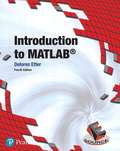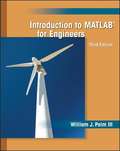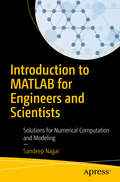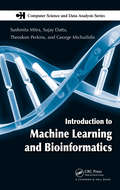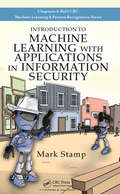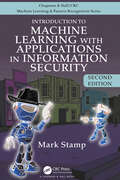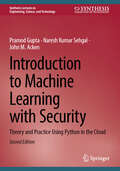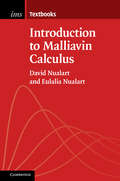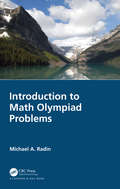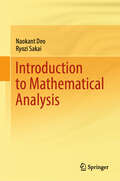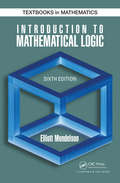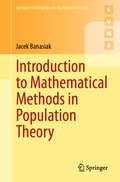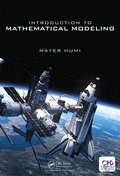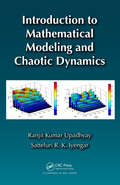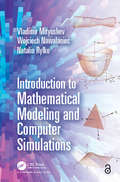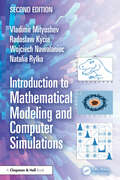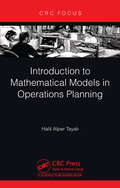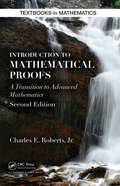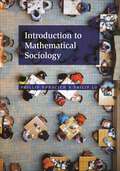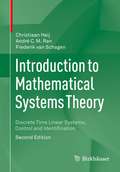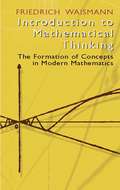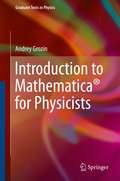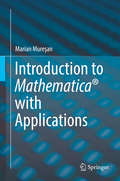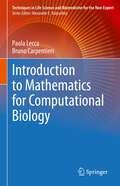- Table View
- List View
Introduction to MATLAB
by Delores EtterThis book is appropriate for use as an introductory engineering text or as a supplemental text in an advanced course. It is also useful as a professional reference. The text will introduce engineering problem solving with the following objectives: (i) Present a consistent methodology for solving engineering problems; (ii) Describe the exceptional computational and visualization capabilities of MATLAB; and (iii) Illustrate the problem-solving process through a variety of engineering examples and applications. Throughout the text, emphasis is placed on incorporating real-world engineering and scientific examples with solutions and usable code. Each chapter ends with a Summary that reviews the topics covered and includes a list of Key Terms. A MATLAB Summary lists all the special symbols, commands, and functions defined in the chapter. Hints are provided to help the student avoid some of the common errors.
Introduction to MATLAB for Engineers
by William J. PalmIntroduction to MATLAB for Engineersis a simple, concise book designed to be useful for beginners and to be kept as a reference. The terminology, syntax, and the use of the programming language are well defined, and the organization of the material makes it easy to locate information and navigate through the textbook. The text covers all the major capabilities of MATLAB that are useful for beginning students.
Introduction to MATLAB for Engineers and Scientists
by Sandeep NagarFamiliarize yourself with MATLAB using this concise, practical tutorial that is focused on writing code to learn concepts. Starting from the basics, this book covers array-based computing, plotting and working with files, numerical computation formalism, and the primary concepts of approximations. Introduction to MATLAB is useful for industry engineers, researchers, and students who are looking for open-source solutions for numerical computation. In this book you will learn by doing, avoiding technical jargon, which makes the concepts easy to learn. First you'll see how to run basic calculations, absorbing technical complexities incrementally as you progress toward advanced topics. Throughout, the language is kept simple to ensure that readers at all levels can grasp the concepts. What You'll Learn Apply sample code to your engineering or science problems Work with MATLAB arrays, functions, and loops Use MATLAB's plotting functions for data visualization Solve numerical computing and computational engineering problems with a MATLAB case study Who This Book Is For Engineers, scientists, researchers, and students who are new to MATLAB. Some prior programming experience would be helpful but not required.
Introduction to Machine Learning and Bioinformatics
by Sushmita Mitra Sujay Datta Theodore Perkins George MichailidisLucidly Integrates Current ActivitiesFocusing on both fundamentals and recent advances, Introduction to Machine Learning and Bioinformatics presents an informative and accessible account of the ways in which these two increasingly intertwined areas relate to each other. Examines Connections between Machine Learning & Bio
Introduction to Machine Learning with Applications in Information Security
by Mark Stamp<p>Introduction to Machine Learning with Applications in Information Security provides a class-tested introduction to a wide variety of machine learning algorithms, reinforced through realistic applications. The book is accessible and doesn’t prove theorems, or otherwise dwell on mathematical theory. The goal is to present topics at an intuitive level, with just enough detail to clarify the underlying concepts. <p>The book covers core machine learning topics in-depth, including Hidden Markov Models, Principal Component Analysis, Support Vector Machines, and Clustering. It also includes coverage of Nearest Neighbors, Neural Networks, Boosting and AdaBoost, Random Forests, Linear Discriminant Analysis, Vector Quantization, Naive Bayes, Regression Analysis, Conditional Random Fields, and Data Analysis. <p>Most of the examples in the book are drawn from the field of information security, with many of the machine learning applications specifically focused on malware. The applications presented are designed to demystify machine learning techniques by providing straightforward scenarios. Many of the exercises in this book require some programming, and basic computing concepts are assumed in a few of the application sections. However, anyone with a modest amount of programming experience should have no trouble with this aspect of the book. <p>Instructor resources, including PowerPoint slides, lecture videos, and other relevant material are provided on an accompanying website: http://www.cs.sjsu.edu/~stamp/ML/. For the reader’s benefit, the figures in the book are also available in electronic form, and in color.
Introduction to Machine Learning with Applications in Information Security (Chapman And Hall/crc Machine Learning And Pattern Recognition Ser.)
by Mark StampIntroduction to Machine Learning with Applications in Information Security, Second Edition provides a classroom-tested introduction to a wide variety of machine learning and deep learning algorithms and techniques, reinforced via realistic applications. The book is accessible and doesn’t prove theorems, or dwell on mathematical theory. The goal is to present topics at an intuitive level, with just enough detail to clarify the underlying concepts. The book covers core classic machine learning topics in depth, including Hidden Markov Models (HMM), Support Vector Machines (SVM), and clustering. Additional machine learning topics include k-Nearest Neighbor (k-NN), boosting, Random Forests, and Linear Discriminant Analysis (LDA). The fundamental deep learning topics of backpropagation, Convolutional Neural Networks (CNN), Multilayer Perceptrons (MLP), and Recurrent Neural Networks (RNN) are covered in depth. A broad range of advanced deep learning architectures are also presented, including Long Short-Term Memory (LSTM), Generative Adversarial Networks (GAN), Extreme Learning Machines (ELM), Residual Networks (ResNet), Deep Belief Networks (DBN), Bidirectional Encoder Representations from Transformers (BERT), and Word2Vec. Finally, several cutting-edge deep learning topics are discussed, including dropout regularization, attention, explainability, and adversarial attacks. Most of the examples in the book are drawn from the field of information security, with many of the machine learning and deep learning applications focused on malware. The applications presented serve to demystify the topics by illustrating the use of various learning techniques in straightforward scenarios. Some of the exercises in this book require programming, and elementary computing concepts are assumed in a few of the application sections. However, anyone with a modest amount of computing experience should have no trouble with this aspect of the book. Instructor resources, including PowerPoint slides, lecture videos, and other relevant material are provided on an accompanying website: http://www.cs.sjsu.edu/~stamp/ML/.
Introduction to Machine Learning with Security: Theory and Practice Using Python in the Cloud (Synthesis Lectures on Engineering, Science, and Technology)
by Naresh Kumar Sehgal Pramod Gupta John M. AckenThis book provides an introduction to machine learning, security and cloud computing, from a conceptual level, along with their usage with underlying infrastructure. The authors emphasize fundamentals and best practices for using AI and ML in a dynamic infrastructure with cloud computing and high security, preparing readers to select and make use of appropriate techniques. Important topics are demonstrated using real applications and case studies.
Introduction to Malliavin Calculus (Institute of Mathematical Statistics Textbooks #9)
by David Nualart Eulalia NualartThis textbook offers a compact introductory course on Malliavin calculus, an active and powerful area of research. It covers recent applications, including density formulas, regularity of probability laws, central and non-central limit theorems for Gaussian functionals, convergence of densities and non-central limit theorems for the local time of Brownian motion. The book also includes a self-contained presentation of Brownian motion and stochastic calculus, as well as Lévy processes and stochastic calculus for jump processes. Accessible to non-experts, the book can be used by graduate students and researchers to develop their mastery of the core techniques necessary for further study.
Introduction to Math Olympiad Problems
by Michael A. RadinIntroduction to Math Olympiad Problems aims to introduce high school students to all the necessary topics that frequently emerge in international Math Olympiad competitions. In addition to introducing the topics, the book will also provide several repetitive-type guided problems to help develop vital techniques in solving problems correctly and efficiently. The techniques employed in the book will help prepare students for the topics they will typically face in an Olympiad-style event, but also for future college mathematics courses in Discrete Mathematics, Graph Theory, Differential Equations, Number Theory and Abstract Algebra. Features: Numerous problems designed to embed good practice in readers, and build underlying reasoning, analysis and problem-solving skills Suitable for advanced high school students preparing for Math Olympiad competitions
Introduction to Mathematical Analysis
by Naokant Deo Ryozi SakaiThis book is a straightforward and comprehensive presentation of the concepts and methodology of elementary real analysis. Targeted to undergraduate students of mathematics and engineering, it serves as the foundation for mathematical reasoning and proofs. The topics discussed are logic, methods of proof, functions, real number properties, sequences and series, limits and continuity and differentiation and integration (Riemann integral and Lebesgue integral). The book explains the concepts and theorems through geometrical and pictorial representation. Limits of sequences and functions, topology of metric spaces, continuity of functions and the Cauchy sequence have been thoroughly discussed in the book.
Introduction to Mathematical Logic (Discrete Mathematics and Its Applications)
by Elliott MendelsonThe new edition of this classic textbook, Introduction to Mathematical Logic, Sixth Edition explores the principal topics of mathematical logic. It covers propositional logic, first-order logic, first-order number theory, axiomatic set theory, and the theory of computability. The text also discusses the major results of Godel, Church, Kleene, Rosse
Introduction to Mathematical Methods in Population Theory (Springer Undergraduate Mathematics Series)
by Jacek BanasiakThis textbook provides an introduction to the mathematical methods used to analyse deterministic models in life sciences, including population dynamics, epidemiology and ecology. The book covers both discrete and continuous models. The presentation emphasises the solvability of the equations appearing in the mathematical modelling of natural phenomena and, in the absence of solutions, the analysis of their relevant properties. Of particular interest are methods that allow for determining the long-term behaviour of solutions. Thus, the book covers a range of techniques, from the classical Lyapunov theorems and positivity methods based on the Perron–Frobenius theorem, to the more modern monotone dynamical system approach. The book offers a comprehensive presentation of the Lyapunov theory, including the inverse Lyapunov theorems with applications to perturbed equations and Vidyasagar theorem. Furthermore, it provides a coherent presentation of the foundations of the theory of monotone dynamical systems with its applications to epidemiological models. Another feature of the book is the derivation of the McKendrick–von Foerster equation from the discrete Leslie model and the analysis of the long-term behaviour of its solutions. Designed for upper undergraduate courses and beyond, this textbook is written for students and researchers looking to master the mathematics of the tools commonly used to analyse life science models. It therefore goes somewhat deeper into mathematics than typical books at this level but should be accessible to anyone with a good command of calculus with elements of real and complex analysis and linear algebra; the necessary concepts are collected in the appendices.
Introduction to Mathematical Modeling
by Mayer Humi<p>Introduction to Mathematical Modeling helps students master the processes used by scientists and engineers to model real-world problems, including the challenges posed by space exploration, climate change, energy sustainability, chaotic dynamical systems and random processes. <p>Primarily intended for students with a working knowledge of calculus but minimal training in computer programming in a first course on modeling, the more advanced topics in the book are also useful for advanced undergraduate and graduate students seeking to get to grips with the analytical, numerical, and visual aspects of mathematical modeling, as well as the approximations and abstractions needed for the creation of a viable model.</p>
Introduction to Mathematical Modeling and Chaotic Dynamics
by Ranjit Kumar Upadhyay Satteluri R. IyengarIntroduction to Mathematical Modeling and Chaotic Dynamics focuses on mathematical models in natural systems, particularly ecological systems. Most of the models presented are solved using MATLAB.The book first covers the necessary mathematical preliminaries, including testing of stability. It then describes the modeling of systems from natural sci
Introduction to Mathematical Modeling and Computer Simulations
by Vladimir Mityushev Wojciech Nawalaniec Natalia RylkoIntroduction to Mathematical Modeling and Computer Simulations is written as a textbook for readers who want to understand the main principles of Modeling and Simulations in settings that are important for the applications, without using the profound mathematical tools required by most advanced texts. It can be particularly useful for applied mathematicians and engineers who are just beginning their careers. The goal of this book is to outline Mathematical Modeling using simple mathematical descriptions, making it accessible for first- and second-year students.
Introduction to Mathematical Modeling and Computer Simulations
by Vladimir Mityushev Wojciech Nawalaniec Natalia Rylko Radoslaw Antoni KyciaIntroduction to Mathematical Modeling and Computer Simulations, Second Edition continues to serve as an engaging and accessible textbook for undergraduates studying mathematical modeling and computer simulations. The book is heavily focussed on applications, and so may have a particular appeal to applied mathematicians, engineers, and others working in applied quantitative disciplines. The book may also be useful as a reference text for reference text for early-career stage practitioners. New to this Edition: A new chapter on Machine Learning and Data Analysis in order to account for recent developments in the field. Chapter 9, ‘Asymptotic Methods in Composites’, has been entirely re-written to make it more consistent with industry and scientific standards. Includes an elementary introduction to programming in Python language. The Jupyter notebooks with examples for Chapter 10 and Appendix A are available for a download from www.Routledge.com/9781032661513.
Introduction to Mathematical Models in Operations Planning
by Halit Alper TayalıDiscover the intricate nature of a company's production function and the comprehensive principles of planning operations in this book. Through practical applications and enriched by numerical examples, readers gain essential knowledge of elementary mathematical methods in operations planning. The inclusion of the powerful R programming language, accompanied by code scripts and real-world examples, enhances the learning experience. Blending theory with practice, this resource equips readers with the tools necessary to optimize production systems, make informed decisions, and gain a competitive edge in today's dynamic business landscape.
Introduction to Mathematical Oncology (Chapman & Hall/CRC Mathematical Biology Series)
by Yang Kuang John D. Nagy Steffen E. EikenberryIntroduction to Mathematical Oncology presents biologically well-motivated and mathematically tractable models that facilitate both a deep understanding of cancer biology and better cancer treatment designs. It covers the medical and biological background of the diseases, modeling issues, and existing methods and their limitations. The authors introduce mathematical and programming tools, along with analytical and numerical studies of the models. They also develop new mathematical tools and look to future improvements on dynamical models. After introducing the general theory of medicine and exploring how mathematics can be essential in its understanding, the text describes well-known, practical, and insightful mathematical models of avascular tumor growth and mathematically tractable treatment models based on ordinary differential equations. It continues the topic of avascular tumor growth in the context of partial differential equation models by incorporating the spatial structure and physiological structure, such as cell size. The book then focuses on the recent active multi-scale modeling efforts on prostate cancer growth and treatment dynamics. It also examines more mechanistically formulated models, including cell quota-based population growth models, with applications to real tumors and validation using clinical data. The remainder of the text presents abundant additional historical, biological, and medical background materials for advanced and specific treatment modeling efforts. Extensively classroom-tested in undergraduate and graduate courses, this self-contained book allows instructors to emphasize specific topics relevant to clinical cancer biology and treatment. It can be used in a variety of ways, including a single-semester undergraduate course, a more ambitious graduate course, or a full-year sequence on mathematical oncology.
Introduction to Mathematical Proofs (Textbooks in Mathematics)
by Charles RobertsIntroduction to Mathematical Proofs helps students develop the necessary skills to write clear, correct, and concise proofs.Unlike similar textbooks, this one begins with logic since it is the underlying language of mathematics and the basis of reasoned arguments. The text then discusses deductive mathematical systems and the systems of natural num
Introduction to Mathematical Sociology
by Phillip Bonacich Philip LuA comprehensive textbook on the tools of mathematical sociology and their applicationsMathematical models and computer simulations of complex social systems have become everyday tools in sociology. Yet until now, students had no up-to-date textbook from which to learn these techniques. Introduction to Mathematical Sociology fills this gap, providing undergraduates with a comprehensive, self-contained primer on the mathematical tools and applications that sociologists use to understand social behavior.Phillip Bonacich and Philip Lu cover all the essential mathematics, including linear algebra, graph theory, set theory, game theory, and probability. They show how to apply these mathematical tools to demography; patterns of power, influence, and friendship in social networks; Markov chains; the evolution and stability of cooperation in human groups; chaotic and complex systems; and more.Introduction to Mathematical Sociology also features numerous exercises throughout, and is accompanied by easy-to-use Mathematica-based computer simulations that students can use to examine the effects of changing parameters on model behavior.Provides an up-to-date and self-contained introduction to mathematical sociologyExplains essential mathematical tools and their applicationsIncludes numerous exercises throughoutFeatures easy-to-use computer simulations to help students master concepts
Introduction to Mathematical Systems Theory: Discrete Time Linear Systems, Control and Identification
by Christiaan Heij André C.M. Ran Frederik van SchagenThis book provides an introduction to the theory of linear systems and control for students in business mathematics, econometrics, computer science, and engineering. The focus is on discrete time systems, which are the most relevant in business applications, as opposed to continuous time systems, requiring less mathematical preliminaries. The subjects treated are among the central topics of deterministic linear system theory: controllability, observability, realization theory, stability and stabilization by feedback, LQ-optimal control theory. Kalman filtering and LQC-control of stochastic systems are also discussed, as are modeling, time series analysis and model specification, along with model validation.This second edition has been updated and slightly expanded. In addition, supplementary material containing the exercises is now available on the Springer Link's book website.
Introduction to Mathematical Thinking: The Formation of Concepts in Modern Mathematics (Dover Books on Mathematics)
by Friedrich WaismannThis enlightening survey of mathematical concept formation holds a natural appeal to philosophically minded readers, and no formal training in mathematics is necessary to appreciate its clear exposition of mathematic fundamentals. Rather than a system of theorems with completely developed proofs or examples of applications, readers will encounter a coherent presentation of mathematical ideas that begins with the natural numbers and basic laws of arithmetic and progresses to the problems of the real-number continuum and concepts of the calculus.Contents include examinations of the various types of numbers and a criticism of the extension of numbers; arithmetic, geometry, and the rigorous construction of the theory of integers; the rational numbers, the foundation of the arithmetic of natural numbers, and the rigorous construction of elementary arithmetic. Advanced topics encompass the principle of complete induction; the limit and point of accumulation; operating with sequences and differential quotient; remarkable curves; real numbers and ultrareal numbers; and complex and hypercomplex numbers.In issues of mathematical philosophy, the author explores basic theoretical differences that have been a source of debate among the most prominent scholars and on which contemporary mathematicians remain divided. "With exceptional clarity, but with no evasion of essential ideas, the author outlines the fundamental structure of mathematics." — Carl B. Boyer, Brooklyn College. 27 figures. Index.
Introduction to Mathematica® for Physicists
by Andrey GrozinThe basics of computer algebra and the language of Mathematica are described. This title will lead toward an understanding of Mathematica that allows the reader to solve problems in physics, mathematics, and chemistry. Mathematica is the most widely used system for doing mathematical calculations by computer, including symbolic and numeric calculations and graphics. It is used in physics and other branches of science, in mathematics, education and many other areas. Many important results in physics would never be obtained without a wide use of computer algebra.
Introduction to Mathematica® with Applications
by Marian MureşanStarting with an introduction to the numerous features of Mathematica®, this book continues with more complex material. It provides the reader with lots of examples and illustrations of how the benefits of Mathematica® can be used. Composed of eleven chapters, it includes the following: A chapter on several sorting algorithmsFunctions (planar and solid) with many interesting examplesOrdinary differential equationsAdvantages of Mathematica® dealing with the Pi numberThe power of Mathematica® working with optimal control problems Introduction to Mathematica® with Applications will appeal to researchers, professors and students requiring a computational tool.
Introduction to Mathematics for Computational Biology (Techniques in Life Science and Biomedicine for the Non-Expert)
by Paola Lecca Bruno CarpentieriThis introductory guide provides a thorough explanation of the mathematics and algorithms used in standard data analysis techniques within systems biology, biochemistry, and biophysics. Each part of the book covers the mathematical background and practical applications of a given technique. Readers will gain an understanding of the mathematical and algorithmic steps needed to use these software tools appropriately and effectively, as well how to assess their specific circumstance and choose the optimal method and technology. Ideal for students planning for a career in research, early-career researchers, and established scientists undertaking interdisciplinary research.
